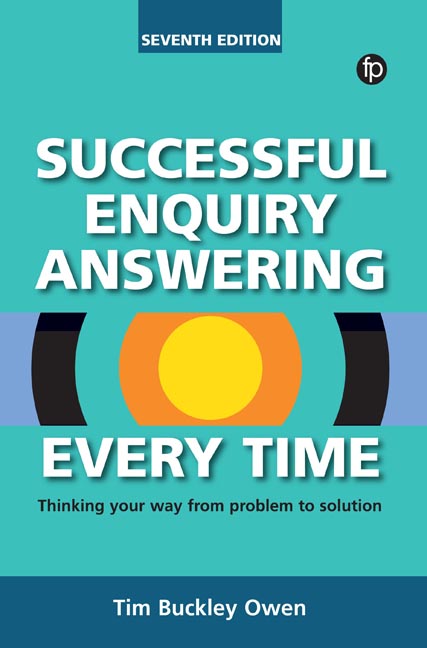Book contents
- Frontmatter
- Dedication
- Contents
- Introduction: Why thinking skills matter
- Eight essential thinking skills for successful enquiry answering
- 1 What do they really want? Using your analytical thinking skills to understand the question
- 2 Why remote enquiry handling is different Anticipating problems by thinking empathetically
- 3 Getting started Dealing with the panic by thinking imaginatively
- 4 Smarter searching Developing efficient search strategies by thinking systematically
- 5 Help! Everything's going wrong Using lateral thinking to get out of difficulties
- 6 Success! Now let's add some value Using your creative thinking skills to present your answer well
- 7 Don't just give me another reading list! Using critical thinking skills to add further value to your answer
- 8 Choosing your toolkit Using your predictive thinking skills to determine the resources you'll need
- Index
- Miscellaneous Endmatter
3 - Getting started Dealing with the panic by thinking imaginatively
Published online by Cambridge University Press: 08 June 2018
- Frontmatter
- Dedication
- Contents
- Introduction: Why thinking skills matter
- Eight essential thinking skills for successful enquiry answering
- 1 What do they really want? Using your analytical thinking skills to understand the question
- 2 Why remote enquiry handling is different Anticipating problems by thinking empathetically
- 3 Getting started Dealing with the panic by thinking imaginatively
- 4 Smarter searching Developing efficient search strategies by thinking systematically
- 5 Help! Everything's going wrong Using lateral thinking to get out of difficulties
- 6 Success! Now let's add some value Using your creative thinking skills to present your answer well
- 7 Don't just give me another reading list! Using critical thinking skills to add further value to your answer
- 8 Choosing your toolkit Using your predictive thinking skills to determine the resources you'll need
- Index
- Miscellaneous Endmatter
Summary
Fear of the unknown is the oldest and strongest kind, said the horror fiction writer H. P. Lovecraft. Well ‘fear’ may be pitching it a bit strong in this context, but if you're anything like most people at this stage in the enquiryanswering process you're certainly feeling pretty nervous and possibly starting to panic. You've listened carefully to your enquirer. You've asked sensible questions. You know exactly what they want. Now your enquirer is waiting for you to help. And you haven't a clue where to start looking.
Fortunately, there are techniques for dealing with this. All you need is a little bit of thinking time. You can buy this time with a positive response – something like: ‘I'm sure I can help; let me just think for a moment where would be the best place to start.’ You'll pick your own form of words, of course, but having a response like this ready all the time is going to be really useful. First, it dispenses instant reassurance to the enquirer; you've promised to help. So, second, that means the enquirer will metaphorically step back and give you the few seconds’ thinking time you need. Third, of course, a response like this commits you to nothing. It certainly doesn't commit you to finding the answer, because you don't know whether you can do that yet. But it does commit you to helping – and you can always help.
How? By exercising your imaginative thinking skills. Let's see how this works in practice …
Imagining the final answer
To deal with the ‘fear’ – or at least the panic – you need to turn the unknown into the known as quickly as possible: in this case, knowing where to go to find the information the enquirer needs. You've just bought yourself some thinking time to help you do this, so how are you going to make the best use of it? It's tempting to simply look busy – turn confidently to the nearest printed reference source you can find, or click onto a search engine and pretend you know what you're doing.
- Type
- Chapter
- Information
- Successful Enquiry Answering Every TimeThinking your way from problem to solution, pp. 47 - 64Publisher: FacetPrint publication year: 2017



